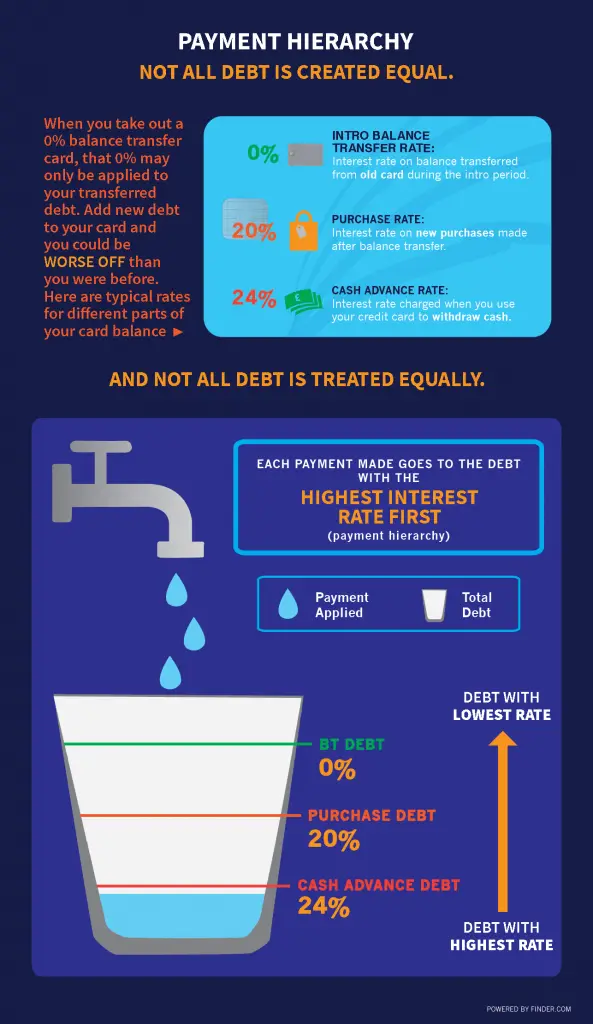Approval for any credit card depends on your status. The representative APRs shown represent the interest rate offered to most successful applicants. Depending on your personal circumstances, the APR you're offered may be higher, or you may not be offered credit at all. Fees and rates are subject to change without notice. It's always wise to check the terms of any deal before you borrow. Most of the data in Finder's comparison tables is provided by Defaqto.
Balance transfer credit cards can be an efficient way to free yourself from high interest and start consolidating your debt. Conducting a balance transfer is a simple process, but repaying your debt before the promotional offer runs out can sometimes be tricky.
Compare balance transfer credit cards
Finder Score for credit cards
To make comparing even easier we came up with the Finder Score. Costs, perks and suitability across 120+ cards are all weighted and scaled to produce a score out of 10. The higher the score the better the card – simple.
Read the full methodologyPay attention to the details of the promotional offer
It’s important to look at these key details when you’re choosing a balance transfer card. Once your balance transfer goes through, take a look at them again:
- How long is the promotional offer? A balance transfer promotional period is generally between 6 months and around 30 months, and it begins as soon as your card is approved (note: this is not necessarily the same date as when you make the transfer). Set reminders on your calendar and/or your phone to prompt you to make regular repayments and to ensure you have plenty of notice before the promotional period ends.
- What’s the interest rate during the promotional period? If you didn’t manage to bag a 0% balance transfer offer, your balance will grow each month: you’ll need to factor this into your repayment plan if you’re going to repay your entire debt by the end of the promotional period.
- What will the interest rate revert to once the promotional period ends? Like all good things, the low promotional rate on your balance transfer won’t last forever. Once it ends, the revert APR will kick in and start collecting interest on your remaining debt. The revert rate is generally much higher. To avoid growing your debt again with interest once the offer expires, make regular repayments, don’t use your card for purchases and make sure you know when the promotional period is going to end.
- How is the minimum repayment calculated? Even if you have a 0% interest rate, you’ll still need to make minimum repayments each month. The amount you have to pay will vary from card to card. Making only minimum payments is unlikely to repay your entire debt by the time the promotional offer ends. Consider the size of your debt, the length of the promotion and the interest rate to calculate how much you will have to pay, or save, each month to ensure that your entire debt is repaid by the end of the offer. If not, your remaining balance will begin accruing interest at the higher revert rate, and you could get stuck in the debt trap once again.
Decide what to do with your old card(s)
Opening a balance transfer credit card doesn’t automatically close your old accounts. If your old card came with a monthly or annual fee, you should close the account to avoid paying fees for something you don’t use. Otherwise, there are pros and cons to keeping them open:
Pros
- Having credit available and not using it keeps your debt-to-credit-limit ratio (also known as your credit utilisation ratio) lower, which is generally looked upon favourably by lenders.
- Keeping your old accounts open may help your credit score by increasing the average age of your credit accounts.
Cons
- If an old card has a low credit limit, then it’s probably not helping your debt-to-credit-limit ratio significantly.
- You might be tempted to use the card(s) again in the future and get into more high-interest debt. The more cards you have, the harder it can be to keep track of them all.
How long does a balance transfer take?
Using your balance transfer credit card for purchases: what you need to know
The purpose of a balance transfer is to consolidate your current debt. Using your balance transfer card to build up more debt on new purchases undermines that goal: here’s why.
- Balance transfer credit cards often charge high interest on purchases. You’re likely to be charged different rates of interest on different parts of your card balance, and your repayments will automatically go to whichever debt is collecting the most interest. That means if you make new purchases on your balance transfer card this month, some or all of your payment next month will go towards paying off those purchases, instead of paying off your balance transfer.
- Cash advances cost even more. A cash advance is when you use your credit card to withdraw cash at a cash machine or to get cashback at the till, and it’s likely to incur an even higher rate of interest than purchases, as well as a fee.
- Interest-free days may not apply to your purchases. Credit cards typically come with around 55 days interest-free on your purchases, but these will not apply if you fail to pay off your purchases each billing cycle.
If you anticipate using the card to make purchases, it may be worth considering a different type of credit card. Your options include a low or 0% interest rate on purchases card. Or if you do want to transfer a balance and make new purchases on the same card, it’s worth looking at “balanced” or “matched” credit cards instead, which offer a 0% interest rate on both purchases and balance transfers (although usually for a shorter introductory period).

After the offer ends
If you find yourself with a remaining debt at the end of your promotional period, you may want to consider doing a second balance transfer to another provider. However, since your credit history will show you weren’t able to repay your debt during the promotional period, lenders may be less likely to approve your application.
Applying for too many credit cards and rejected applications can have a negative impact on your credit file. Lower the risk of having a rejected credit card application by doing an “eligibility check” on the provider’s website first. This is known as a “soft search” which won’t affect your credit history.
If you can’t access another balance transfer, or if you find yourself in a pattern of building up debt and moving it around from card to card, it might be time to find another solution: read our guide to dealing with debt to get an idea of your options.
Bottom line
Balance transfer credit cards can be a worthwhile consolidation tool, but only when used properly: your goal is to pay your debt off, not just move it around. Plan your strategy, make regular repayments and follow the above simple tips to ensure you get the most out of your balance transfer; and if you find yourself relying too heavily on doing one balance transfer after another, consider whether it’s time to get some debt advice.
Frequently asked questions
More guides on Finder
-
How to consolidate credit card debt
If you’ve built a lot of credit card debt, consolidating it into one monthly repayment could make your life easier.
-
How Santander balance transfers work
Find out to transfer a balance using a Santander credit card, and compare 0% balance transfer offers.See how to transg
-
Can I transfer money from a credit card to a bank account?
Weigh up your options when you want to transfer funds from a credit card to a bank account.
-
Can I transfer a balance from someone else’s credit card?
Learn how you can transfer debt from your partner, which card issuers allow this and how to minimise the cost.
-
How much can I transfer with a balance transfer card?
Understand how balance transfer limits work so you can find the right credit card to consolidate your debt and clear it faster.
-
How to do a balance transfer in 9 steps
Make sure your application for a 0% balance transfer credit card is accepted. Get our list of tips for increasing your chance of approval.
-
Is it possible to do a second balance transfer?
Weigh the pros and cons of a second balance transfer to get your credit card debt under control.
-
Can you transfer multiple credit cards with a balance transfer?
If you have a lot of debt on multiple credit cards, you may have been considering moving all of the balances to one card. Find out how to do so in this article.
-
Can I balance transfer a personal loan to a credit card?
Had enough of paying a hefty rate of interest on your personal loan? Discover how you can repay your debt faster with 0% money transfer offers.
